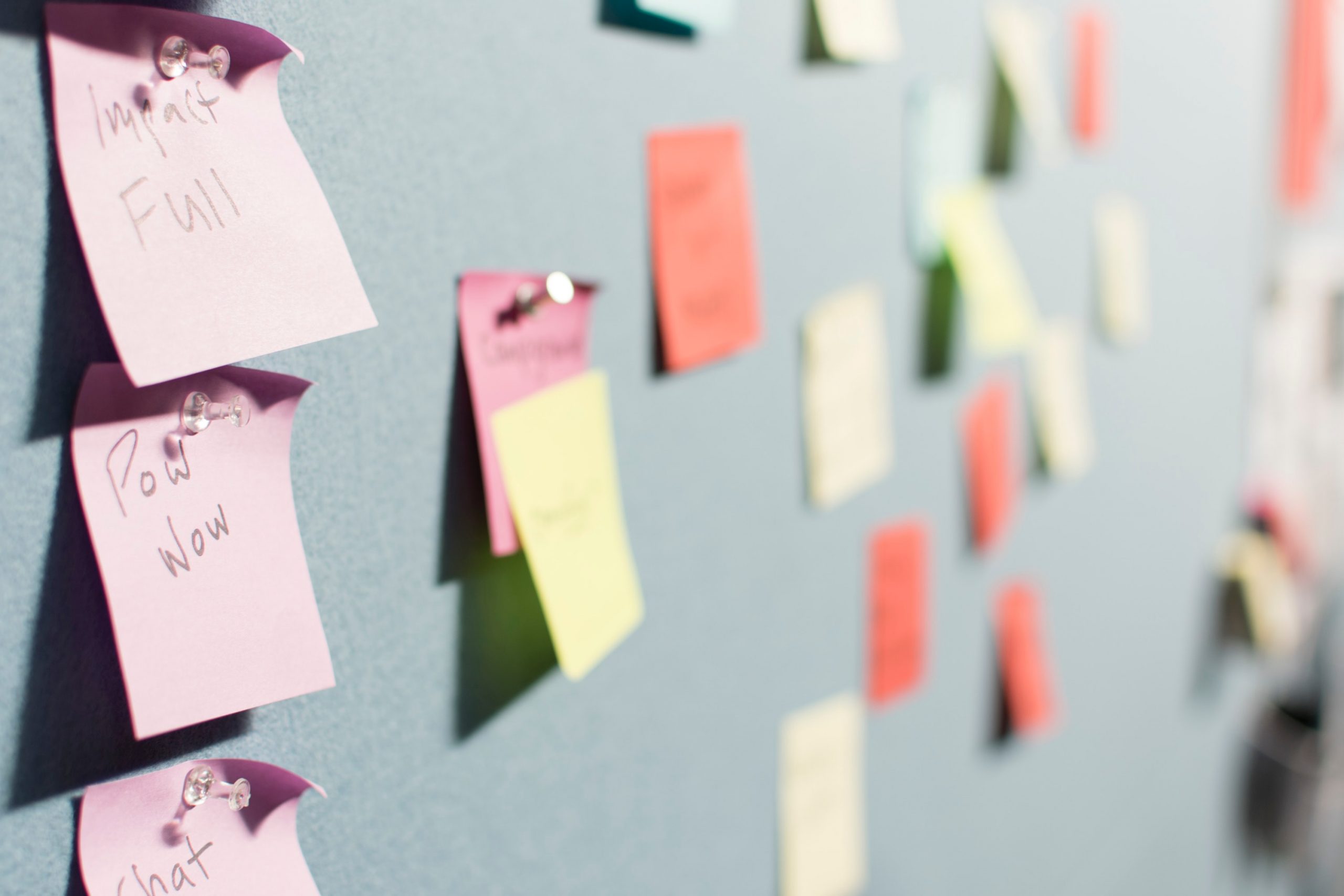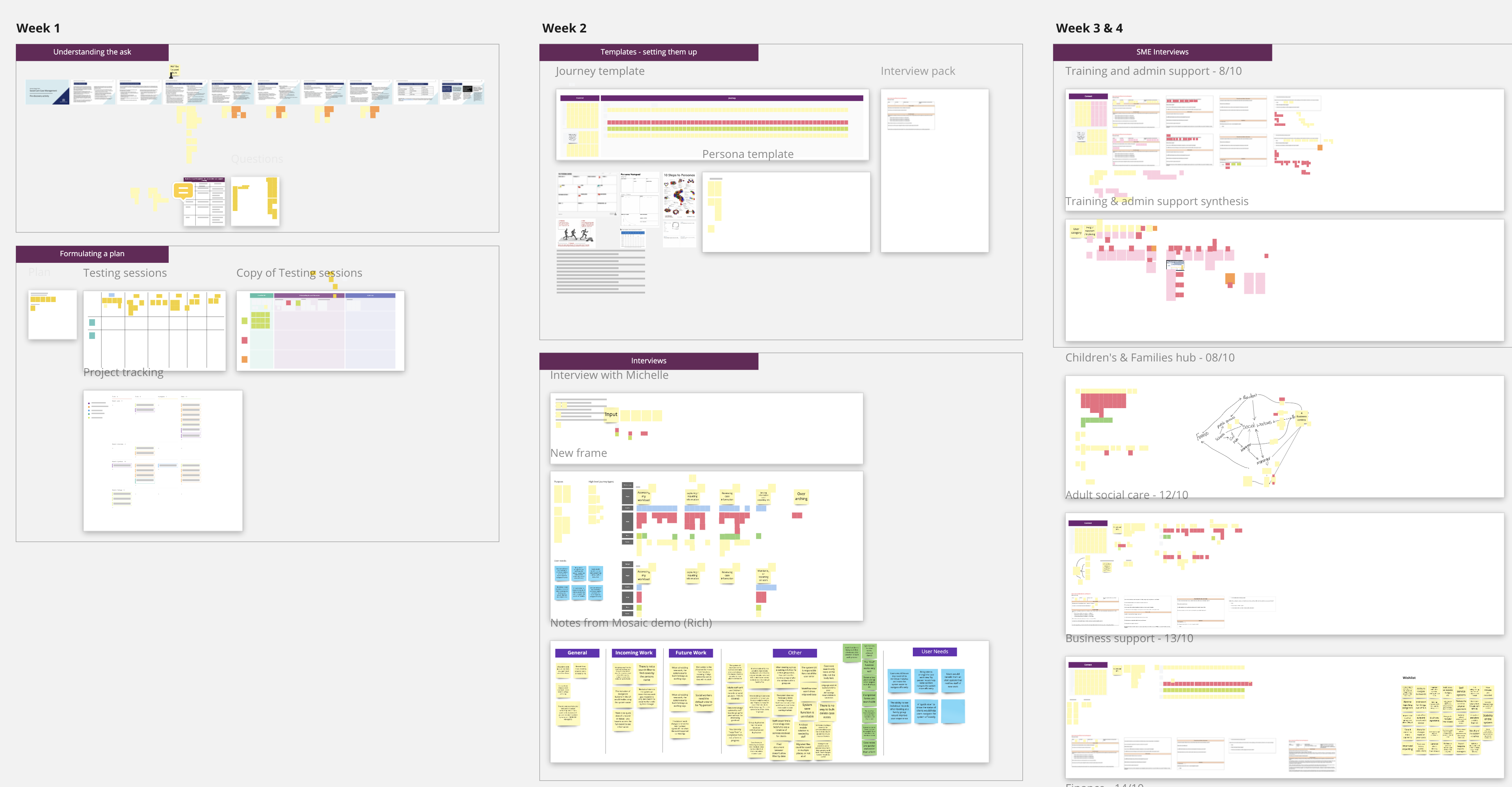
In February, we started working on a pre-discovery to help a programme team understand the experiences users of their Social Care Case Management system, looking at their pains, gains, needs and aspirations.
Our progress was paused in March by coronavirus, but when the cogs started turning again in September we were asked, what can you do in a really short space of time?
Getting started
Rich:
The initial scope of the pre-discovery was pretty big. Before the work was paused, we had started speaking to users of the system to understand their experiences and needs as well as arranging conversations with peer organisations to get a better understanding of the software they had chosen and the experiences they had.
Picking this up again several months later was daunting, but what we already knew helped us pinpoint where we thought we could add the most value. Scaling back and focusing on the user experience meant that could provide a high-level perspective and provide telling insights.
Chanel:
We started to break down some tasks and put together an ideal timeframe and what potential outputs might be. Lead Service Designer, Nic Ward, then put a spanner in the works and asked us to think about the maximum amount of value we could provide in the shortest timeframe.
Thinking big and then scaling it back actually helped because we were able to take into account where we were hoping to get to and think about a smaller scale of those outputs. For instance, we had hoped to provide personas but scaling that back due to the limited number of interviews we could do meant that we could provide short user profiles instead.
These still gave an indication of the user group, their pains, other systems used, aspirations and fears. Enough to take forward when making decisions around the core system and how to handle change management.
When it doesn't work, what do you do?
When we got going, it became clearer that this wasn't what the project team were expecting. A refinement of our scope was needed.
Rich:
After spending a week conducting interviews and gathering insights it became clear that expectations didn't quite line up between ourselves and the wider programme team. Under normal circumstances there would be a bit more time to look at the original scope and agree on the direction. But in this instance time was the one resource we really didn't have.
In Service Transformation, we often talk about iterative working practice - being able to recognise failure fast and changing course to make sure the work is successful. This project is the perfect example. When we realised the work wasn't landing as expected, we regrouped and reshaped what we would deliver, gaining agreement in one afternoon.
Another pair of eyes is always helpful with this process and luckily for us, Nic was there to help us refocus. Phew - back on course!
Chanel:
As we spent some time discussing who to interview with the various stakeholders, it became clear that there was some misalignment between the original scope and what the team had expected from the piece of work.
There was a subject matter expert (SME) for Children’s and Families Social Care assigned to the project but without an SME for Adult Social Care, we could not commit to those interviews.
With stakeholders, it was agreed that there would be a limited view on this for now. But as an SME in Adult Social Care came on board, we were able to adjust and include those interviews to provide a more well-rounded view. Luckily we had kept some additional time in our back pockets in case we needed it. It was a good thing we did!
Making sense of what we had done
We had tons of data, but we needed to find a way to work together to make it meaningful.
Rich:
This can be really tricky, especially when both of you are very close to the data and have clear ideas on how the insights should be presented. Miro (a digital whiteboard) enabled us to put everything in one place so that we could discuss, group and distil all of our insights to shape a narrative we were both happy with. This sounds easy but often this where things come tumbling down.
Chanel has incredible Miro skills, making working with this tool a breeze, but more importantly we listened to each other - a lot!
It's so important that all parties have an equal voice for the final output to land well - something that both of us were very respectful of.

Chanel:
Going into the interviews, we were prepared to capture the data in a certain way. However, we soon learned that the information gathered didn’t fit into a neat little journey with pain points and so we quickly adjusted our note-taking approach.
Rich and I had different ways of grouping the information from the interviews, and it was great to share what we had got from the interviews to form our insights. We worked in a way that complemented our strengths and communicated openly to fill the gaps.
But what is the output?
Rich:
We worked together on producing a PowerPoint deck that showcased user needs in several categories: user interface, key functionality and so on. We thought the best approach was to divide and conquer, with each of us taking a section and then coming together to make sure it was telling the right story.
I found this way of working refreshing and ensured both of our voices were represented in the report. This helped take pressure off each of us when we presented the report back to the programme team.
On top of this, Chanel created user profiles, and thanks to her wizardry, a spreadsheet was generated from the Miro board showing the user needs. This meant that the programme team were able to cut the data in different ways and made finding key insights easy.
Chanel:
This is where things got a bit tricky - taking all those insights and making something that tells the story of the user groups. Using our trusty Miro board, we affinity sorted and wrote user needs to ensure we had agreement on them.
As for the report, we generated the overall narrative in a shared PowerPoint presentation. And just as we'd done before, broke the work up based on our strengths before coming together to tie it up.
Part of our process was sharing it with Nic, and User Research Lead, Jane Reid, to provide feedback and help us shape it before the final delivery. Neither Rich nor I are particularly comfortable presenting, so having the report put together in this way meant that we were more comfortable delivering it.
What we learned
Rich:
Collaboration is more than a buzz word! The project had a very tight timescale, the scope needed refinement and the output had to be valuable. Without Chanel and I working well together at every stage doing planning, interviews, report writing and presenting, the discovery would not have been successful.
I find presenting back (especially virtually) quite uncomfortable, largely due to not having had to do it that often. After the presentation we held a retro to discuss what we felt went well and what didn't. I received some great tips for presenting and feel a lot more confident to present in future. A very valuable lesson.
I think the biggest lesson was not something I learnt from this project, but was certainly reminded of: it's good to get it wrong. Uncomfortable? Definitely, but it opens up the opportunity to think about things differently.
Chanel:
Rule number 1: keep it simple! Don’t overthink it. Every time we got into the weeds, we had remember to take a step back.
Also, in order to get clarity, you need to be less afraid of asking questions to stakeholders. You have nothing to lose and clarity to gain.
Working together collaboratively is so important. Throughout the project we listened to each other and contributed equally. We communicated often and this allowed us to adjust quickly. The result was a piece of work we could both talk about comfortably.
I'm great in a workshop where everyone's learning and sharing, but I'm not comfortable with the pressure that comes with delivering a presentation. Working remotely, this becomes even trickier. It's a growth area I'm working through, and it can only get better with practice.
Leave a comment